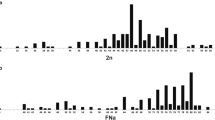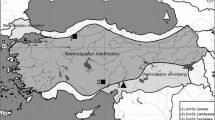Abstract
We analyzed the restriction fragment length polymorphism of class I and class II MHC genes in DNA from 20 individuals belonging to the four different species of the complex of species of Balkan mole rats Spalax leucodon captured at four different localities in Yugoslavia. All populations were tested with four restriction enzymes and one conserved mouse probe for each of the two classes of MHC genes. The probes employed detect either limited polymorphism of class I genes or lack of polymorphic bands containing class II genes. Of the two other subterranean rodents that have been studied, four karyotype forms of the Israeli mole rat show polymorphism in both classes of MHC genes similar to the one found in all other mammals (Nižetić et al. 1985), and the Syrian hamster shows limited polymorphism of class I genes and high polymorphism of class II genes (McGuire et al. 1985). Balkan mole rats belong to a new group in this respect, different from all mammals studied so far, since they apparently show limited polymorphism of both classes of MHC genes.
Similar content being viewed by others
References
Bregegere, F., Abastado, J. P., Kvist, S., Rask, L., Lalanne, J. L., Garoff, H., Cami, B., Wiman, K., Larnammar, D., Peterson, P. A., Gachelin, G., Kourilsky, P., and Dobberstein, B.: Structure of C-terminal half of two H-2 antigens from cloned mRNA. Nature 292: 78–81, 1981
Darden, A. G. and Streilein, J. W.: Syrian hamsters express two monomorphic class I major histocompatibility complex molecules. Immunogenetics 20: 603–622, 1984
Davis, M. M., Cohen, D. I., Nielsen, E. A., Steinmetz, M., Paul, W. E., and Hood, L.: Cell-type-specific cDNA probes and the murine I region: the localization and orientation of A& d. Proc. Natl. Acad. Sci. U.S.A. 81: 2194–2198, 1984
Feinberg, A. P. and Vogelstein, B.: A method for rapid labeling DNA. Anal. Biochem. 132: 6–11, 1983
Fox, M. and Zeiss, J. M.: The chromosome preparation from fresh and cultured tissues using a modification of drying technique. Nature 188: 1213–1214, 1961
Gromov, I. and Baranova, G. I.: Catalogue of Mammals in USSR (in Russian), p. 455, Nauka, Leningrad, 1981
Herrman, B., Bucan, M., Mains, P. E., Frishauf, A.-M., Silver, L. M., and Lechrach, H.: Genetic analysis of the proximal portion of the mouse t complex: evidence for second inversion within t haplotypes. Cell 44: 469–476, 1986
Hood, L. E., Steinmetz, M., and Malissen, B.: Genes of the major histocompatibility complex of the mouse. Ann. Rev. Immunol. 1: 529–568, 1983
Klein, J.: Evolution and function of major histocompatibility system: fact and speculations. In D. Goetze (ed.): The Major Histocompatibility System in Man and Animals, pp. 339–371, Springer-Verlag, Berlin, 1977
Klein, J. and Figueroa, F.: Evolution of the major histocompatibility complex. CRC Crit. Rev. Immunol. 6: 295–388, 1986
Klein, J., Figueroa, F., and Nagy, Z. A.: Genetics of the major histocompatibility complex: the final act. Ann. Rev. Immunol. 1: 119–142, 1983
McGuire, K. L., Duncan, W. R., and Tucker, P. W.: Syrian hamster DNA shows limited polymorphism at class L-like loci. Immunogenetics 22: 257–268, 1985
Nei, M. and Li, W. H.: Mathematical model for studying genetic variation in terms of restriction endonucleases. Proc. Natl. Acad. Sci. U.S.A. 76: 5269–5273, 1979
Nevo, E.: Speciation in Subterranean Mammals. In C. Barigozzi (ed.): Mechanism of Speciation, pp. 191–218, Alan R. Liss, New York, 1982
Nižetić, D.: Evolution of the Major Histocompatibility Multigene Family Studied on Spalax Ehrenbergi Model, doctoral dissertation, University of Belgrade, Belgrade, Yugoslavia, 1987
Nižetić, D., Figueroa, F., Mueller, H. J., Arden, B., Nevo, E., and Klein, J.: Major histocompatibility complex of the mole-rat. I. Serological and biochemical analysis. Immunogenetics 20: 443–451, 1984
Nižetić, D., Figueroa, F., Nevo, E., and Klein, J.: Major histocompatibility complex of the mole-rat. II. Restriction fragment polymorphism. Immunogenetics 22: 55–67, 1985
Nižetić, D., Figueroa, F., Dembić, Z., Nevo, E., and Klein, J.: Major histocompatibility complex gene organization in mole rat. Spalax ehrenbergi: evidence for transfer of function between class II genes. Proc. Natl. Acad. Sci. U.S.A. 84: 5828–5833, 1987
Orr, H. T.: Use of the Southern blotting to analyse the size and restriction fragment polymorphism of HLA class I DNA in the human population. Transplant. Proc. 15: 1900–1906, 1983
Palmer, M., Wettstein, P. J., and Frelinger, J. A.: Evidence for extensive polymorphism in class I genes of the major histocompatibility complex (RT-1). Proc. Natl. Acad. Sci. U.S.A. 72: 1184–1188, 1983
Philips, J. T., Streilein, J. W., and Duncan, W. R.: The biochemical characterization of Syrian hamster cell-surface alloantigens. I. Analysis of allogenic differences between recently wild and highly inbred hamsters. Immunogenetics 7: 445–455, 1978
Savić, I.: Ecology of the mole rat (Spalax leucodon Norm.) in Yugoslavia. (In Serbo-Croatian) Zbornik za prirodne nauke 44: 1–70, 1973
Savić, I. and Soldatović, B.: Distribution range and evolution of chromosomal forms in the Spalacidae of the Balkan Peninsula and bordering regions. J. Biogeogr. 6: 363–374, 1979
Savić, I, and Soldatović, B.: Karyotype evolution and taxonomy of the genus Nannospalax Palmer, 1903, Mammalia, in Europe. Serbian Acad. Sci. and Arts 59: 1–104, 1984
Schopfer, R., Figueroa, F., Nižetić, D., Nevo, E., and Klein, J.: Evolutionary diversification of class II P loci and Mhc of the mole-rat Spalax ehrenbergi. Mol. Biol. Evol. 4: 287–299, 1987
Silver, L. M.: Genome analysis of the H-2 complex region associated with mouse t Haplotypes. Cell 29: 961–968, 1982
Steinmetz, M., Stephan, D., and Fisher-Lindahl, K.: Gene organization and recombinational hotspots in the murine major histocompatibility complex. Cell 44: 895–904, 1986
Streilein, J. W. and Duncan, W. R.: On the anomalous nature of the major histocompatibility complex in Syrian hamsters. Hm-1. Transplant. Proc. 15: 1540–1545, 1983
Vincek, V., Nižetić, D., Golubić, M., Figueroa, F., Nevo, E., and Klein, J.: Evolutionary expansion of Mhc class I loci in the mole rat, Spalax ehrenbergi. Mol. Biol. Evol. 4: 483–491, 1987
Wahrman, J., Goiten, R., and Nevo, E.: Mole rat Spalax: evolutionary significance of chromosome variation. Science 164: 82–84, 1969
Author information
Authors and Affiliations
Rights and permissions
About this article
Cite this article
Nižetić, D., Stevanović, M., Soldatović, B. et al. Limited polymorphism of both classes of MHC genes in four different species of the Balkan mole rat. Immunogenetics 28, 91–98 (1988). https://doi.org/10.1007/BF00346156
Received:
Revised:
Issue Date:
DOI: https://doi.org/10.1007/BF00346156




